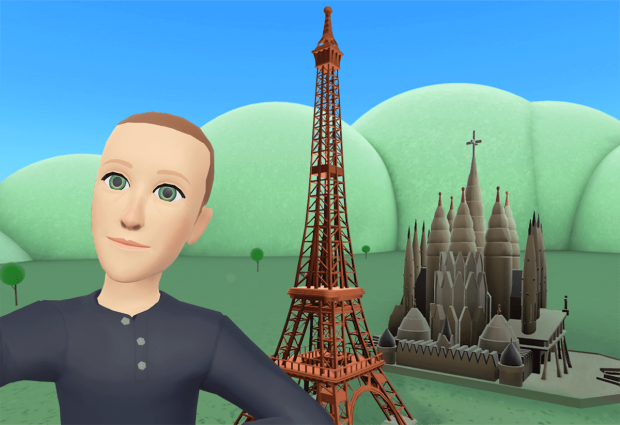Meta Metaverse Weekly: In Horizon Worlds, Emperor Has No Legs

If you thought analysts and investors have been cruel to Mark Zuckerberg’s metaverse dreams, wait till you see what the Twitterverse has been saying about the “selfie” he used to announce Horizon Worlds’ debut in France and Spain.
Among the terms used to describe the picture of CEO Mark Zuckerberg’s avatar standing in front of the Eiffel Tower and Barcelona’s Sagrada Familia cathedral were “soulless” from gaming site Kokatu and “dead-eyed” via Forbes.
Then there was “2022 lovechild of The Sims and Nintendo Wii” from University College of London political science professor Brian Klass, who prefaced that by saying, “There needs to be a German word that’s like schadenfreude, but specifically for how wonderful it is to see the company that helped break democracy pour $10 billion down the drain.”
There needs to be a German word that’s like schadenfraude, but specifically for how wonderful it is to see the company that helped break democracy pour $10 billion down the drain to create this hilarious 2022 lovechild of The Sims and Nintendo Wii. pic.twitter.com/czVcGQUBdM
— Brian Klaas (@brianklaas) August 17, 2022
“Break democracy” refers to accusations that Facebook data was used to skew the 2020 presidential elections — the phrase was used by Sen. Sherrod Brown (D-Ohio) to attack Zuckerberg and Facebook shortly after the launch of the failed Libra/Diem stablecoin project in 2019.
See also: Facebook Diem: Move Fast, Break Things, Then Crash Into a Wall
The news itself was semi-interesting: Horizon Worlds, which began life as a portal for the company’s bestselling Quest line of VR goggles, has expanded into Europe, adding Spain and France, and increasing customization options — by which it apparently means the ability to “block, mute, or report anyone engaging in unwanted behavior” via pop-up Safe Zone that all new users will have to learn about in the onboarding process.
The metaverse may be in beta, but accusations of in-world harassment are well established.
It’s worth remembering here that Horizon Worlds isn’t the metaverse platform the company has spent something on the order of $15 billion on in the last year and a half. It’s kind of a halfway house in which people can get a flavor of the idea of the metaverse as an immersive, interactive space.
Still, as more than a few commentors pointed out, the avatars’ lack of legs does seem a bit dated.
The top blockchain-based metaverse projects, Decentraland and The Sandbox, are somewhat better, as are the (fully legged and more realistic) bodies in Second Life and Fortnite — but not especially so in Roblox.
Citing the Forbes article, Second Life took the opportunity to start a Twitter thread asking players to take selfies in front of the Eiffel Tower.
Up for another #SecondLifeChallenge? Take a snapshot of your avatar in front of the Eiffel Tower in #SecondLife and share it with us! https://t.co/sraPJQh3DQ
Strawberry took hers at virtual Paris City: https://t.co/TGOL6iBrcI pic.twitter.com/9zsawcil9u
— Second Life (@SecondLife) August 17, 2022
All the mockery does make an important point, which is that the generic metaverse is still a long way off and that other projects are still in diapers as well. And, realistically, most people who aren’t involved in a metaverse are likely hearing about it in large part as something Meta is working on — it was Zuckerberg’s decision to change Facebook’s name to Meta and declare metaverses the future of social media that mainstreamed the concept.
So it probably isn’t great for the highest profile metaverse to be the one that is the poorest in terms of visually immersive quality.
Snapping Up Discounts
Drink-maker Snapple made itself an early adopter of the metaverse’s much-talked-about ability to connect in-game brand marketing to real-world goods with its Blockchain Bodega marketing play.
The company built a New York City-style corner store in Decentraland and added a scavenger hunt, in which players can earn $1.39 rebate codes usable in real life — albeit, CoinDesk noted, only if you’ve got a PayPal wallet. There’s no crypto payment option yet.
But buyers of real-life Snapple Elements drinks can get a bottlecap code redeemable for a metaverse-wearable nonfungible token (NFT) clothing item.
